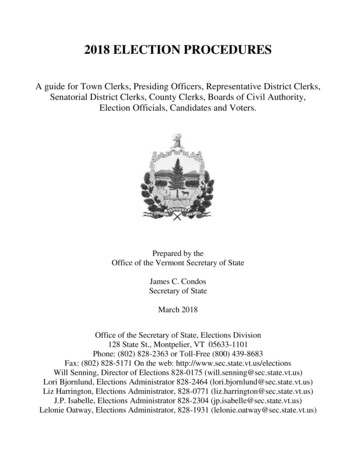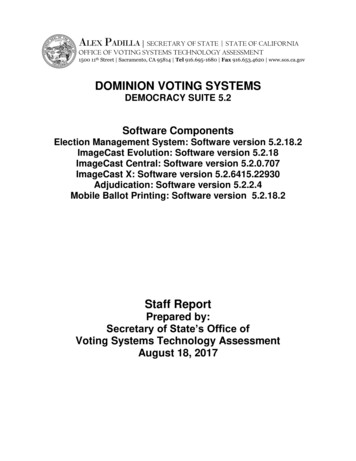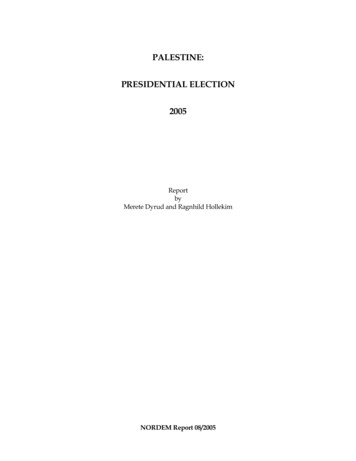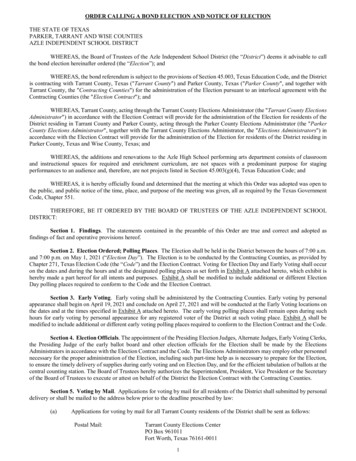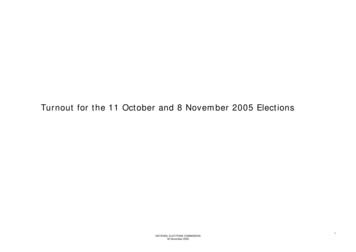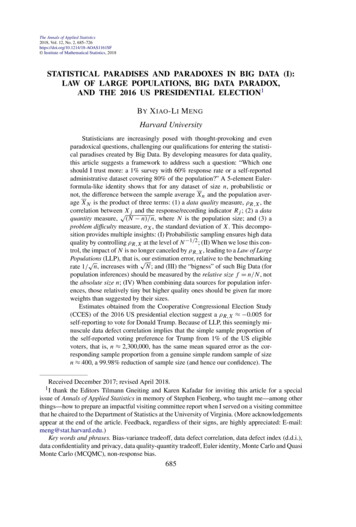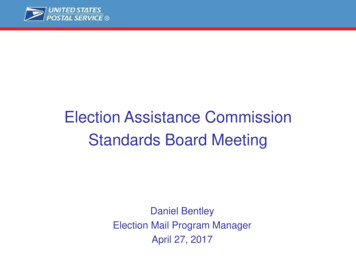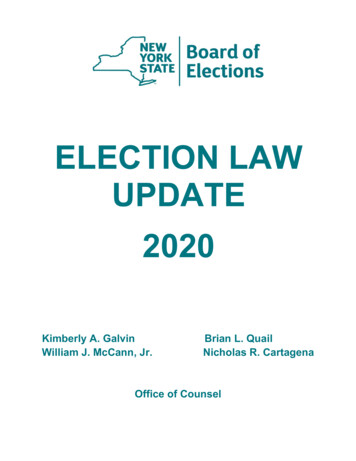
Transcription
ELECTION LAWUPDATE2020Kimberly A. GalvinWilliam J. McCann, Jr.Brian L. QuailNicholas R. CartagenaOffice of Counsel
TABLE OF CONTENTSINTRODUCTION . 1REGISTRATION AND ENROLLMENT. 2Residency . 2Voter Residency . 2Dual Residency. 2Residency of Absentee Voter . 3Residency of Candidate . 4Parties. 6Rules of New Party . 6Certificates of Nomination By New Party . 6Post Primary Reorganization. 6Changing Party Enrollment . 7Political Party Enrollment and the Closed Primary . 7Cancelling Enrollment. 8Affiliated Voters. 8ELECTION DAY . 9Polling Place Accessibility . 9Write-In Voting . 10Absentee Voter . 10POST ELECTION . 10Review of Cast Ballots . 10Inactive Voters . 13Affidavit Voting . 13Abandoned / Non-machine Processable Optical Scan Ballots . 13Audit Provisions . 14Manual Recount . 15Review of Validity of Primary Election. 16Review of Validity of General Election. 16PETITIONS . 16Board of Elections Authority Regarding Petitions . 16Form and Contents of Petitions . 17Number of Signatures Needed . 17Invalidity of a Single Signature . 18No Requirement that Signatures Be Sequential . 19Cover Sheets . 19Page Numbers . 20Preamble . 20Committee to Fill Vacancies . 20Candidate on Petition . 21Qualifications for Office . 21Running for Judicial Office . 21Running for Two Offices. 22Over Designations. 22
Voter Registration of the Candidate . 22Enrollment and Authorization of the Candidate . 22Candidate's Identifying Information . 23Name . 23Residence and Address of Candidate . 23Title of Office or Position . 24Signer of Petition . 26Date . 26Name . 26Residence. 27Town or City . 28Signed Previous Petition . 29Independent Body Name . 30Witness Statement. 30Residency of Witness Stated on Petition . 30Party of Witness . 32Witness Identification Information. 32Completion of Witness Information . 33Number of Signatures. 33Previously Witnessing or Signing Petition . 34Previous Participation in a Caucus. 34Signing and Dating . 35Signatures Taken by Notary or Commissioner of Deeds . 35Alterations . 37Alterations to the Signers Line . 37Material Alteration . 37Fraud . 38Opportunity to Ballot Petitions . 39Opportunity to Ballot as Equitable Remedy . 40Independent Nominations Placement on the Ballot . 40NOMINATIONS . 41Caucuses . 41Posting Notice of Caucus. 41Rule Limiting Nominees to Enrolled Party Members is Invalid . 42Judicial Nominating Conventions . 42Delegates to Convention . 42Delegate Residency . 42Filing of Certificate of Nomination. 43VACANCIES . 43Certification of Vacancies . 43Disqualification . 44Hatch Act Disqualification . 44Residency Disqualification . 44Substitutions . 44CHALLENGES . 45Objections . 45
Standing to Object . 45Independent Petitions . 45Objections To Party Petitions / Certificates For Public Office . 45Objections Where Objector’s Enrollment Matters . 46Judicial Convention Objections . 46County Committee . 46When Objections Must Be Received . 47Postmarks. 47Rehearing . 48Service of Objections on the Candidate . 48Hatch Act . 49Joinder in Special Proceeding. 49LOCAL REFERENDA . 49ELECTION LAW §3-300. 50PREEMPTION OF ELECTION LAW . 50CAMPAIGN FINANCIAL DISCLOSURE . 51Contribution Limit Constitutionality . 51New York State Board 2016 Opinion # 1 . 52Party Money in a Primary . 53NOTABLE RECENT LEGISLATION. 532020 Laws . 532019 Laws . 562020 EXECUTIVE ORDERS. 59PROOF ISSUES. 73Correcting Defects: Issues of Proof. 73Proof Generally . 73ELECTION LAW VIOLATIONS. 74Election Law Violations . 74COURT ACTIONS . 74Judicial Review . 74Relief Impossible . 75Party Chair Standing . 75Table Summarizing Actions . 76Service of Process. 79Affirmative Relief--A Separate Proceeding. 79Notice to Attorney General of Constitutional Challenge . 79Table Summarizing New York Court System . 80
INTRODUCTIONThe Election Law Update is a guide for election officials on topics related toelection administration. This Update is based upon reported as well as unreportedcases the State Board is a party to or made aware of.The Update is not an exhaustive review of every election law case. It is simply astarting point. It does not replace the need to seek the advice of counsel.Please feel free to contact our office if you are aware of any cases that should belisted or if you require any additional information.1
REGISTRATION AND ENROLLMENTTo vote in an election in New York State, a person must be registered to vote (NYConst. Art II § 5; Election Law § 5-100). Registration with the County Board of Electionsentitles a person to vote in all contests for public office that occur relating to the politicaljurisdictions wherein the person resides (NY Const. Art II § 6).ResidencyResidency is rarely challenged at the time a person registers to vote. Typically,residency issues arise in the absentee and affidavit ballot canvassing process, thepetitioning process or when a candidate’s residency or duration of residency ischallenged. A voter’s residence and duration of residence determines where the personmay register to vote and sometimes whether a person can be a candidate for a publicoffice. When and how residency may be challenged depends on the specific context.Voter ResidencyIn determining residency, the Board may consider the voter applicant's financialindependence, business pursuits, employment, income sources, residence for income taxpurposes, age, marital status, residence of parents, spouse and children, if any,leaseholds, sites of personal and real property owned by the applicant, motor vehicle andother personal property registration and such other factors that it may reasonably deemnecessary to determine the qualification of an applicant to vote within the Board'sjurisdiction (Election Law § 5-104 [2]). “The crucial factor in determining if an individual isqualified to register and vote from a particular residence is whether he or she hasmanifested an intent to adopt that residence as a permanent and principal home coupledby his or her physical presence there ‘without any aura of sham’” (Matter of Thompson vKarben, 295 AD2d 438, 439 [2d Dept 2002], citing People v O’Hara, 96 NY2d 378, 385[2001], quoting Matter of Gallagher v Dinkins, 41 AD2d 946, 947 [2d Dept 1973]; aff’d 32NY2d 839 [1973]).Dual ResidencyA person with two residences "may choose one to which she has legitimate,significant and continuing attachments as her residence for purposes of the Election Law"(Ferguson v McNab, 60 NY2d 598, 600 [1983]; Matter of Willkie v Delaware County Boardof Elections, 55 AD3d 1088 [3d Dept 2008] [authorizes a choice of voting place for thosewho own or maintain dual residences and rejecting a limited interpretation that votingrights may only be premised upon “domicile”]).2
In Matter of Shafer v Dorsey (43 AD3d 621 [3d Dept 2007], lv denied 9 NY3d 804[2007]), in the context of a candidate challenge under Election Law § 16-102, the Courtdenied the challenge on grounds of dual residency affording the candidate the right tochoose from which of his residences he would run, “with emphasis on Dorsey’s‘expressed intent and conduct’. and finding no fraudulent or deceptive motive in Dorsey’schoice of residence” (Shafer at 623 [quoting People v O’Hara at 384]; see also Matter ofJohnson v Simpson, 43 AD3d 478 [2d Dept 2007] lv denied 9 NY3d 804 [2007]; Maas vGaebel, 129 AD3d 178 [2d Dept 2015] [holding “fact that one’s position on a specificpolitical issue may serve as a motivating factor to register to vote in a place where he orshe has established a bona fide residence does not render such a residence a ‘sham’”]).The Second Circuit Court of Appeals observed in Wit v Berman (306 F3d 1256 [2dCir. 2002]) that "New York has responded to this administrative difficulty [persons withmultiple homes] in a pragmatic way. New York courts have held that, rather than compelpersons in appellants' circumstances to establish to the satisfaction of a registrar of votersor a court that one home or the other is their principal, permanent residence, they canchoose between them” (Wit at 263; see also People v O'Hara, 96 NY2d 378, 385 [2001][“[a]n individual having two residences may choose one to which she has legitimate,significant and continuing attachments as her residence for purposes of the ElectionLaw'”] quoting Matter of Ferguson v McNab, 60 NY2d 598, 600 [1983]). “This pragmaticapproach lessens the burdens on registrars, who in most cases need only verify anaddress, and on people like appellants, who otherwise might be turned down at bothplaces and have to go to court in order to be able to vote anywhere” (Wit at 1262).Residency of Absentee VoterGenerally, in a proceeding pursuant to Election Law § 16-106 for judicial reviewof the canvass of votes in a general election, the courts lack authority to render adetermination as to whether a voter was ‘lawfully registered and eligible to vote’ (Matterof Johnson v Martins, 79 AD3d 913, 920 [2d Dept 2010] quoting Matter of Mondello vNassau County Bd. of Elections, 6 AD3d 18, 20-21 [2d Dept 2004]). However, “[w]ithinthe limited authority afforded under article 16, Supreme Court has jurisdiction overallegations of certain serious irregularities in the conduct of a general electionincluding challenges to absentee ballots based on nonresidency.” (Matter of Delgadov Sunderland (97 NY2d 420, 423 [2002] [emphasis added]; Mondello at 21; Matter ofAmedore v Peterson, 102 AD3d 995, 998 [3d Dept 2013], lv denied 20 NY3d 1006[2013]).A challenge to an absentee voter’s residency may be made at the time ofcanvass. The objector bears the burden of overcoming the presumption that the voterresides where he/she is registered to vote (Matter of Amedore v Peterson, 102 AD3d995, 998 [3d Dept 2013], lv denied 20 NY3d 1006 [2013]). An allegation that an3
absentee voter simply does not reside where he or she claims to reside falls into thecategory of “certain serious irregularities” courts will entertain at the time of the canvass.In contrast, a challenge to a person’s selection of a voting address as between dualresidences may be in a different category. In Matter of Fingar v Martin (68 AD3d 1435[3d Dept 2009]) the Court held “to the extent that petitioners do, in fact, premise anychallenges on voters' dual residency, we note that the law regarding a voter choosingamong residences for election purposes is interpreted broadly and a challenge to suchresidency should be made pursuant to the procedure to challenge the issuing of theabsentee ballots and not, as here, after those ballots have been cast” (Id. at 1436[internal citations omitted]). In Amedore, the Third Department clarified that “challengesto absentee ballots based on nonresidency” were permitted at the time of canvass and“[t]o the extent that Matter of Fingar v Martin holds that individuals who are notcommissioners of the board of elections must raise such arguments at the time anabsentee ballot is issued, it is not to be followed” (Amedore at 998, n5 [quoting Delgadoat 423; see generally Messina v Albany County Bd. Of Elections, 66 AD3d 1111, 1114[3d Dept 2009]). An absentee voter whose ballot is challenged based on nonresidencyis not a necessary party to an Election Law § 16-106 challenge to the canvass of theballot. The Third Department rejected the argument that a challenge to an absenteeballot based on the voter’s nonresidency is, in essence, a challenge to the voter’sregistration (Meyer v Whitney, 132 AD3d 1062 [3d Dept 2015]).Residency of CandidateThere is no state law requirement that a candidate for a local office reside in thedistrict in which election is sought at the time the petition is filed (Clark v McCoy, 196AD2d 607 [2d, Dept. 1993] lv denied, 82 N.Y.2d 653). “Election Law § 6-122 simplyprohibits a person from being designated or nominated for public office who cannotmeet the statutory or constitutional qualifications at the ‘commencement of the term ofsuch office’. Public Officers Law § 3 (1) adds that candidates satisfy residencyrequirements as of the time they are elected” (Weidman v Starkweather, 80 N.Y.2d 955[1992]).Local charters or laws may impose more stringent residency requirements forlocal offices (Scavo v Albany County Board of Elections, 131 AD3d 796 [3d Dept 2015][holding board properly exercised ministerial powers in finding county legislaturecandidate did not meet one-year county charter residency requirement when hisaddress on designating petition was not in the district]).Candidates for Governor or Lieutenant Governor must be a resident of the statefor the “five years next preceding the election” (N.Y. Const. Art. IV Section 2). Similarly,candidates for the office of Member of New York State Senate or Assembly must meettwo constitutional residency requirements: Five years of residency in the state andresidency in the district for “twelve months immediately preceding his or her election.”4
The residency period must be continuous, not intermittent (Bourges v LeBlanc, 98 NY2d418 [2002]). For the election immediately following redistricting, a candidate for statelegislature is not required to have lived in the district but must have resided within thecounty in which the district is contained for twelve months immediately before theelection (NY Const, Art. III, Section 7). The factors for determining voter residencyapply equally to candidate residency. A challenge to a candidate’s residency will failunless “clear and convincing evidence” demonstrates the challenged candidate doesnot meet the constitutional residency requirement (Weiss v Teachout, 120 AD3d 701[2d Dept 2014]; see also Jones v Blake, 120 AD3d 415 [2014]).Courts examine several factors to determine whether a candidate meets aresidency requirement. There is no single test. But notably the Court of Appeals heldthat a candidate fails the Constitutional residency requirement when he or she registersto vote in another jurisdiction during the required residency period. In Glickman v Laffin(27 N.Y.3d 810 [2016]), the Court of Appeals held that a candidate’s prior voterregistration in Washington, D.C. precluded him from establishing the requiredcontinuous five-year residency in New York. The court held that the D.C. voterregistration broke the chain of his New York electoral residency which did notrecommence until he registered again to vote in New York. However, the FirstDepartment held that Glickman is not a bright line test. In Quart v Kaufman, the FirstDepartment held that a candidate’s prior voter registration, and voting history, inConnecticut did not, in and of itself, preclude the candidate from establishing therequired continuous five-year residency in New York. (2020 NY Slip Op 02904 [1stDept May 14, 2020], lv to appeal denied, 2020 NY Slip Op 66363 [May 19, 2020]). TheCourt looked at other factors in establishing residency, including the fact thatConnecticut law, unlike the law in Washington D.C., does not require a voter to attestthat Connecticut is the voter’s sole electoral residence.However, the Second Department has held that a candidate's prior voterregistration, and voting history, in North Carolina did, in fact, sever the candidate'selectoral residency with New York State, precluding the candidate from establishing therequired five year residency. Notaristefano v Marcantonio, 164 AD3d 721 [2d Dept2018], lv to appeal denied, 31 NY3d 1210 [2018].In Dilan v Salazar, appearing on the rolls as a registered voter in another stateduring the residency period was distinguished from voting or filing a registrationapplication in another state during the residency period (164 AD3d 713 [2d Dept 2018]).Accordingly, a candidate on the voter rolls in Florida during the residency period whohad neither voted nor registered during the residency period was not removed from theballot (Id).Issues relating to sufficiency of the description of a candidate’s address on apetition or certificate are covered in the Petition section.5
PartiesThe term “party” means any political organization which at the last precedingelection for governor received, at least two percent of the total votes cast for its candidatefor governor, or one hundred thirty thousand votes, whichever is greater, and at least twopercent of the total votes cast for its candidate for president, or one hundred thirtythousand votes, whichever is greater, in a year when a president is elected. Election Law§ 1-104 (3). The term “major political parties” means the two parties which polled for theirrespective candidates for the office of governor the highest and next highest number ofvotes at the last preceding election for such office. Election Law § 1-104 [24].Rules of New PartyThree appellate division decisions in 2015 grappled with the validity of the rules ofthe Women’s Equality Party pursuant to Election Law § 6-128. The Third Department inGrasso v Cleveland found “no statutory support for petitioner’s assertion that the newparty rules must be certified by a majority of the statewide candidates in the 2014 generalelection in order to be valid” (132 AD3d 1059 [2015]). The court noted one set of ruleswas certified by two statewide candidates, while the other two sets of rules were notcertified by any statewide candidate of the new party. “Absent such statewide candidatesupport, they cannot be deemed rules of the WEP for the purpose of creating a ‘questionor conflict relating to the rules or the rule-making body’” (Id; see also DeLabio v Allen, 131AD3d 1340 [4th Dept 2015]; Donovan v Cabana, 132 AD3d 919 [2d Dept 2015] [decidedon different grounds]; Dadey v. Czarny, 132 AD3d 1427 [4th Dept 2015] [decided onsimilar grounds]).Certificates of Nomination By New PartyThe certificate of nomination issued by a newly formed party pursuant to ElectionLaw § 6-128 must include an affidavit “containing a statement by the presiding officer andsecretary of the committee that they are such officers and the statements in the certificateare true.” In McCormack v Jablonski the Second Department found the challengedcertificate included a “notarized signature” identifying the presiding officer and secretary,but not “a statement by either attesting to the truth of the statements in the certificate”(132 AD3d 921 [2015]). The court determined “[t]h
To vote in an election in New York State, a person must be registered to vote (NY Const. Art II § 5; Election Law § 5-100). Registration with the County Board of Elections entitles a person to vote in all contests for public office that occur relating to the political jurisdictions wherein the person resides (NY Const. Art II § 6).

